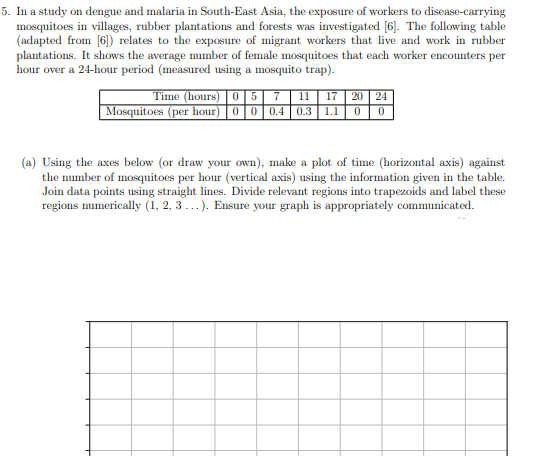Answered step by step
Verified Expert Solution
Question
1 Approved Answer
5. In a study on dengue and malaria in South-East Asia, the exposure of workers to disease-carrying mosquitoes in villages, rubber plantations and forests


5. In a study on dengue and malaria in South-East Asia, the exposure of workers to disease-carrying mosquitoes in villages, rubber plantations and forests was investigated [6]. The following table (adapted from [6]) relates to the exposure of migrant workers that live and work in rubber plantations. It shows the average number of female mosquitoes that each worker encounters per hour over a 24-hour period (measured using a mosquito trap). Time (hours) |0|57 11 17 20 24 Mosquitoes (per hour) |0|0|0.4 0.3| 1.1 | 0 0 (a) Using the axes below (or draw your own), make a plot of time (horizontal axis) against. the number of mosquitoes per hour (vertical axis) using the information given in the table. Join data points using straight lines. Divide relevant regions into trapezoids and label these regions numerically (1, 2, 3 ...). Ensure your graph is appropriately communicated. (b) Determine the total exposure to disease-carrying mosquitoes for each rubber plantation worker over the 24-hour period using the trapezoid rule. Explain the meaning of the value that you calculate. (c) (Advanced) Villagers who work in the local forests encounter, on average, 1.5 mosquitoes per hour when working from 6 am until 5 pm each day. Which of the two populations (migrants in rubber plantations or villagers in the forests) experience a higher exposure to dengue (carried by mosquitoes), and by what factor?
Step by Step Solution
There are 3 Steps involved in it
Step: 1

Get Instant Access to Expert-Tailored Solutions
See step-by-step solutions with expert insights and AI powered tools for academic success
Step: 2

Step: 3

Ace Your Homework with AI
Get the answers you need in no time with our AI-driven, step-by-step assistance
Get Started


